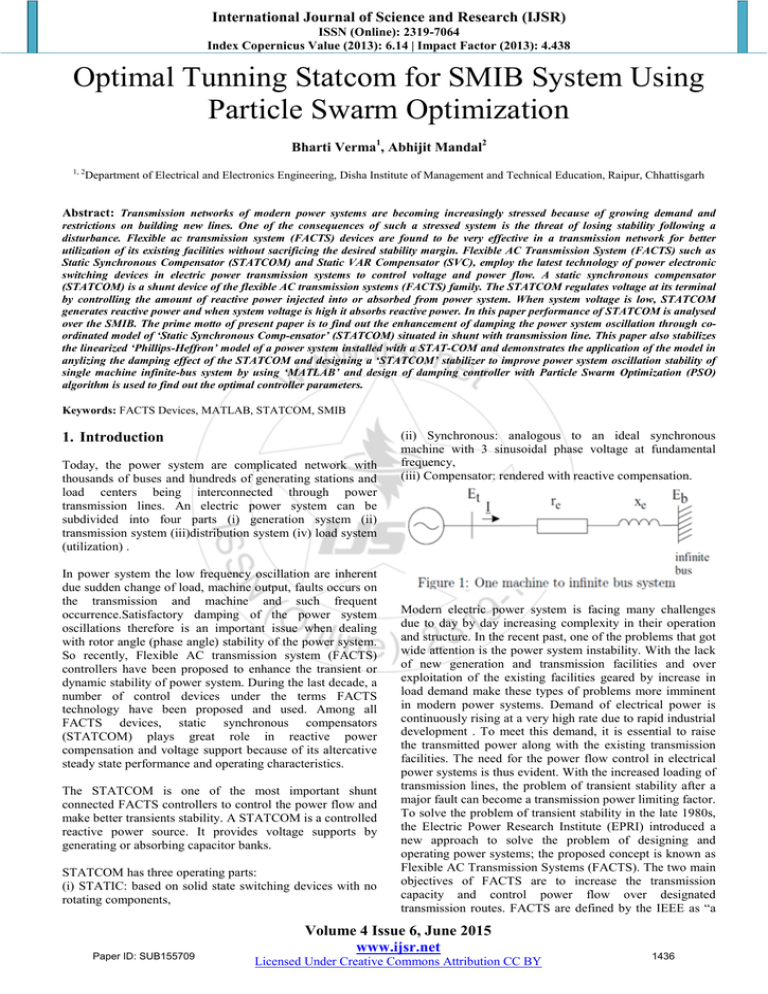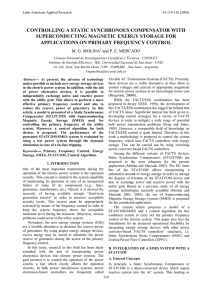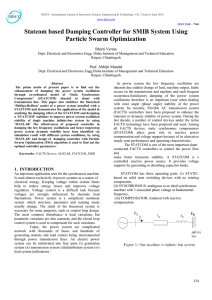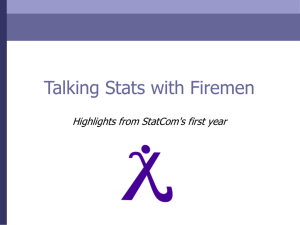Optimal Tunning Statcom for SMIB System Using Particle Swarm
advertisement

International Journal of Science and Research (IJSR) ISSN (Online): 2319-7064 Index Copernicus Value (2013): 6.14 | Impact Factor (2013): 4.438 Optimal Tunning Statcom for SMIB System Using Particle Swarm Optimization Bharti Verma1, Abhijit Mandal2 1, 2 Department of Electrical and Electronics Engineering, Disha Institute of Management and Technical Education, Raipur, Chhattisgarh Abstract: Transmission networks of modern power systems are becoming increasingly stressed because of growing demand and restrictions on building new lines. One of the consequences of such a stressed system is the threat of losing stability following a disturbance. Flexible ac transmission system (FACTS) devices are found to be very effective in a transmission network for better utilization of its existing facilities without sacrificing the desired stability margin. Flexible AC Transmission System (FACTS) such as Static Synchronous Compensator (STATCOM) and Static VAR Compensator (SVC), employ the latest technology of power electronic switching devices in electric power transmission systems to control voltage and power flow. A static synchronous compensator (STATCOM) is a shunt device of the flexible AC transmission systems (FACTS) family. The STATCOM regulates voltage at its terminal by controlling the amount of reactive power injected into or absorbed from power system. When system voltage is low, STATCOM generates reactive power and when system voltage is high it absorbs reactive power. In this paper performance of STATCOM is analysed over the SMIB. The prime motto of present paper is to find out the enhancement of damping the power system oscillation through coordinated model of ‘Static Synchronous Comp-ensator’ (STATCOM) situated in shunt with transmission line. This paper also stabilizes the linearized ‘Phillips-Heffron’ model of a power system installed with a STAT-COM and demonstrates the application of the model in anylizing the damping effect of the STATCOM and designing a ‘STATCOM’ stabilizer to improve power system oscillation stability of single machine infinite-bus system by using ‘MATLAB’ and design of damping controller with Particle Swarm Optimization (PSO) algorithm is used to find out the optimal controller parameters. Keywords: FACTS Devices, MATLAB, STATCOM, SMIB 1. Introduction Today, the power system are complicated network with thousands of buses and hundreds of generating stations and load centers being interconnected through power transmission lines. An electric power system can be subdivided into four parts (i) generation system (ii) transmission system (iii)distribution system (iv) load system (utilization) . In power system the low frequency oscillation are inherent due sudden change of load, machine output, faults occurs on the transmission and machine and such frequent occurrence.Satisfactory damping of the power system oscillations therefore is an important issue when dealing with rotor angle (phase angle) stability of the power system. So recently, Flexible AC transmission system (FACTS) controllers have been proposed to enhance the transient or dynamic stability of power system. During the last decade, a number of control devices under the terms FACTS technology have been proposed and used. Among all FACTS devices, static synchronous compensators (STATCOM) plays great role in reactive power compensation and voltage support because of its altercative steady state performance and operating characteristics. The STATCOM is one of the most important shunt connected FACTS controllers to control the power flow and make better transients stability. A STATCOM is a controlled reactive power source. It provides voltage supports by generating or absorbing capacitor banks. STATCOM has three operating parts: (i) STATIC: based on solid state switching devices with no rotating components, Paper ID: SUB155709 (ii) Synchronous: analogous to an ideal synchronous machine with 3 sinusoidal phase voltage at fundamental frequency, (iii) Compensator: rendered with reactive compensation. Modern electric power system is facing many challenges due to day by day increasing complexity in their operation and structure. In the recent past, one of the problems that got wide attention is the power system instability. With the lack of new generation and transmission facilities and over exploitation of the existing facilities geared by increase in load demand make these types of problems more imminent in modern power systems. Demand of electrical power is continuously rising at a very high rate due to rapid industrial development . To meet this demand, it is essential to raise the transmitted power along with the existing transmission facilities. The need for the power flow control in electrical power systems is thus evident. With the increased loading of transmission lines, the problem of transient stability after a major fault can become a transmission power limiting factor. To solve the problem of transient stability in the late 1980s, the Electric Power Research Institute (EPRI) introduced a new approach to solve the problem of designing and operating power systems; the proposed concept is known as Flexible AC Transmission Systems (FACTS). The two main objectives of FACTS are to increase the transmission capacity and control power flow over designated transmission routes. FACTS are defined by the IEEE as “a Volume 4 Issue 6, June 2015 www.ijsr.net Licensed Under Creative Commons Attribution CC BY 1436 International Journal of Science and Research (IJSR) ISSN (Online): 2319-7064 Index Copernicus Value (2013): 6.14 | Impact Factor (2013): 4.438 power electronic based system and other static equipment that provide control of one or more AC transmission system parameters to enhance controllability and increase power transfer capability”. “A Static synchronous compensator is a shunt-connected static VAR compensator whose capacitive or inductive output current can be controlled independent of the ac system voltage”.The concept of STATCOM was proposed by Gyugyi in 1976. Power Converter employed in the STATCOM mainly of two types i.e. is Voltage Source Converter and Current Source Converter. In Current source Converter direct current always has one polarity and the power reversal takes place through reversal of dc voltage polarity while In Voltage Source Converter dc voltage Figure 3: Phillips Heffron model 3. PSO Figure 2: Basic Structure of STATCOM always has one polarity, and the power reversal takes place through reversal of dc current polarity. The power semiconductor devices used in current source converter requires bidirectional voltage blocking capability and for achieving this Characteristic an additional diode must be connected in series with a semiconductor switch which increased the system cost and its becomes costlier as compared to voltage source converter moreover Voltage source converter can operate on higher efficiency in high power applications. STATCOM is made up of a coupling transformer, a VSC and a dc energy storage device. STATCOM is capable of exchanging reactive power with the transmission line because of its small energy storage device i.e. small dc capacitor, if this dc capacitor is replaced with dc storage battery or other dc voltage source, the controller can exchange real and reactive power with the transmission system, extending its region of operation from two to four quadrants. 2. Phillips Heffron Model For the study of single machine infinite bus system a Phillips Heffron model can be obtained by linearizing the system equations around an operating condition. The obtained hefffron model is as shown in figure below In computer science, particle swarm optimization (PSO) is a computational method that optimizes a problem by iteratively trying to improve a candidate solution with regard to a given measure of quality. PSO optimizes a problem by having a population of candidate solutions, here dubbed particles, and moving these particles around in the searchspace according to simple mathematical formulae over the particle's position and velocity. Each particle's movement is influenced by its local best known position but, is also guided toward the best known positions in the search-space, which are updated as better positions are found by other particles. This is expected to move the swarm toward the best solutions. PSO algorithm is an optimization technique inspired by the natural movement and intelligence of bird flocks and fish schooling. It was first introduced by Eberhart and Kennedy in 1995 to graphically simulate the graceful and unpredictable choreography of a swarm . The basic idea of the PSO consists in moving a pre-defined number of particles troughout the searching space in order to find the best solution. The movement pattern of the particles towards the best solutions is defined by the social interaction between the individuals from the population. In Fig. 4 are represented the main steps for implementing the PSO algorithm. For mathematical representation of the flock, the particles are modeled as vectors in a multidimensional search space. The optimization process starts by randomly generating the population and the velocities of the particles. To assign a certain measure of performance, the particles are evaluated according to an objective function. In this way, the personal best of each particle as well as the global best of the entire population are determined. With this information, the velocity of every individual is computed taking into account its previous velocity, personal best and global best . The new positions of the individuals are then updated by adding the computed velocities to the actual position according to .(1) vik+1=wvik+c1.rand.(pbesti-sik)+ c2.rand.(gbesti-sik) where: Paper ID: SUB155709 Volume 4 Issue 6, June 2015 www.ijsr.net Licensed Under Creative Commons Attribution CC BY 1437 International Journal of Science and Research (IJSR) ISSN (Online): 2319-7064 Index Copernicus Value (2013): 6.14 | Impact Factor (2013): 4.438 c1 , c2 Weighting coefficients pbesti Personal best of the ith particle gbest Global best of the population sik Position of the ith particle at iteration k Sik+1 =Sik+Vik+1 ………… (1) where: si k1 The position of the ith particle at iteration k+1 vi k1 Velocity of the ith particle at iteration k+1 The searching process is continued until a relatively unchanged position has been encountered or computational limits are exceeded. An important aspect of the PSO is that the ratios of the three elements that influence the particle velocity in the optimization process can be modified. Therefore, the particle performance toward the optimal solution can be enhanced controlling the weighting coefficients. Figure 5: Proposed model in simulink 5. Conclusion Solving an optimization problem is one of the common scenarios that occur in most engineering applications. The above issues are of particular importance when solving optimization problems in a power system. As a highly nonlinear, nonstationary system with noise and uncertainties, a power network can have a large number of states and parameters. Implementing any of the classical analytical optimization approaches might not be feasible in most of the cases. On the other hand, PSO can be an alternative solution. It is a stochastic-based search technique that has its roots in artificial life and social psychology, as well as in engineering and computer science. It utilizes a “population,” called particles, which flows through the problem hyperspace with given velocities; in each iteration, velocities are stochastically adjusted considering the historical best position for the particle itself and the neighborhood best position (both of them defined according to a predefined fitness function). Then, the movement of each particle naturally evolves to an optimal or near-optimal solution.This paper has described the basic concepts of PSO along with its numerous variants that can be employed in different optimization problems. In addition, a review of the applications of PSO in power systems-based optimization problems is presented to give the reader some insight of how PSO can serve as a solution to some of the most complicated engineering optimization problems. Figure 4: Block diagram of PSO algorithm 4. Simulation Methodology Figure 6: Rotor angle deviation without statcom Paper ID: SUB155709 Volume 4 Issue 6, June 2015 www.ijsr.net Licensed Under Creative Commons Attribution CC BY 1438 International Journal of Science and Research (IJSR) ISSN (Online): 2319-7064 Index Copernicus Value (2013): 6.14 | Impact Factor (2013): 4.438 References [1] Hingorani and N.G.Gyungi – “Understanding Facts Devices”- IEEE Press, 2000 [2] Girma S. Tewolde, Darrin M. Hanna, and Richard E. Haskell, ―Enhancing Performance of PSO with Automatic Parameter TuningTechnique‖, IEEE, 2009. [3] A. Chatterjee S. P. Ghoshal V. Mukherjee, ―A Comparative Study of Single Input and Dual Input Power System Stabilizer by Hybrid Evolutionary Programming‖, World Congress on Nature & Biologically Inspired Computing (NaBIC), 2009. [4] IEEE Recommended Practice for Excitation System Models for Power System Stability Studies‖, IEEE Power Engineering Society Sponsored by the Energy Development and Power Generation Committee, 2009. [5] A.jeevanandham and K.Thanushkodi,‖optimization of power system stabilizers relaying on particle swarm optimizers‖, ICGST, December 2008. [6] R.Grondin ,I. Kamwa, , and G. Trudel, ―IEEE PSS2B Versus PSS4B: The Limits of Performance of Modern Power System Stabilizers‖, IEEE transactions on power systems, vol. 20, no. 2., 2005. [7] P.Kundur, ―Power system Stabilizer and Control‖, Mcgraw hill, 2004. [8] Wenyan. Gu, "System damping improvement using adaptive power system stabilizer," Proc IEEE Canadian Conference on Electrical and Computer Engineering, pp. 1245-1247, 2004. [9] P.M.Anderson and A.A.Fouad, ‖Power System Control and Stability‖, Vol-1, Lowa State University Press, USA, 2003. [10] M. A. Abido, "Robust design of multi-machine power system stabilizers using simulated annealing," IEEE Trans. Energy Conversion, vol. 15, no.3, pp. 297-304, Sep. 2002. [11] WANG, H.F.,and SWIFT, F.J,: „An unified model for the analysis of FACTS devices in damping power system oscillations. Part I:single-machine-bus power system‟, IEEE Trans. Pwr. Deliv.,1997,12,(2),pp. 941926. [12] Modeling STATCOM into power system: H. F. Wang University of both, Bath BA2 7AY,UK. [13] P.M. Anderson and A.A. Fouad, 1994, Power System Control and Stability, IEEE Press, [14] Rogers G.; Power System Oscillations, 2000, Kluwer Academic publishers. [15] H. F. Wang, July 2000, “A Unified model for the analysis of FACTS devices in damping power system oscillations-Part III:Unified power flow controller,” IEEE Trans. On Power Delivery,vol. 15, no. 3, pp 978983. [16] H.F. Wang, Sept. 1999, “Phillips-Heffron model of power system installed with STATCOM and applications.” IEEE Proc.-Geer, Trans. Distr, Vol. 146 No. 5. [17] Damping of Power System Oscillation by using coordinated tuning of POD and PSS with STATCOM by, A.S.P. Kanojia and B.Dr. V.K. Chandrakar. [18] Jalilvand, Member, IEEE, M. Daviran Keshavarzi and M. Khatibi, ―Optimal Tuning of PSS Parameters for Damping Improvement Using PSO Algorithm‖, The 4th International Power Engineering and Optimization Paper ID: SUB155709 Conf. (PEOCO2010), Shah Alam, Selangor, Malaysia: 23-24 June 2010. [19] X.P.Zhang and B.Pal, “Flexible AC Transmissions systems : Modelling and Control”, Springer Berlin Heidelberg, New York. [20] SVC and STATCOM.”, IEEE proceedings on Power Engineering Review, Vol 19, No 8, pp:57-58, Aug1999. Volume 4 Issue 6, June 2015 www.ijsr.net Licensed Under Creative Commons Attribution CC BY 1439








